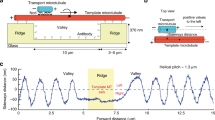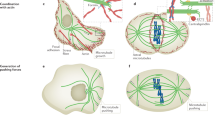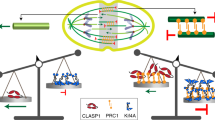Abstract
Microtubule-crosslinking motor proteins, which slide antiparallel microtubules, are required for the remodeling of microtubule networks. Hitherto, all microtubule-crosslinking motors have been shown to slide microtubules at a constant velocity until no overlap remains between them, leading to the breakdown of the initial microtubule geometry. Here, we show in vitro that the sliding velocity of microtubules, driven by human kinesin-14 HSET, decreases when microtubules start to slide apart, resulting in the maintenance of finite-length microtubule overlaps. We quantitatively explain this feedback using the local interaction kinetics of HSET with overlapping microtubules that cause retention of HSET in shortening overlaps. Consequently, the increased HSET density in the overlaps leads to a density-dependent decrease in sliding velocity and the generation of an entropic force that antagonizes the force exerted by the motors. Our results demonstrate that a spatial arrangement of microtubules can regulate the collective action of molecular motors through the local alteration of their individual interaction kinetics.
This is a preview of subscription content, access via your institution
Access options
Access Nature and 54 other Nature Portfolio journals
Get Nature+, our best-value online-access subscription
$29.99 / 30 days
cancel any time
Subscribe to this journal
Receive 12 print issues and online access
$259.00 per year
only $21.58 per issue
Buy this article
- Purchase on Springer Link
- Instant access to full article PDF
Prices may be subject to local taxes which are calculated during checkout






Similar content being viewed by others
References
She, Z.-Y. & Yang, W.-X. Molecular mechanisms of kinesin-14 motors in spindle assembly and chromosome segregation. J. Cell Sci. 130, 2097–2110 (2017).
Cai, S., Weaver, L.N., Ems-McClung, S.C. & Walczak, C.E. Kinesin-14 family proteins HSET/XCTK2 control spindle length by cross-linking and sliding microtubules. Mol. Biol. Cell 20, 1348–1359 (2009).
Goshima, G., Nédélec, F. & Vale, R.D. Mechanisms for focusing mitotic spindle poles by minus end-directed motor proteins. J. Cell Biol. 171, 229–240 (2005).
Lecland, N. & Lüders, J. The dynamics of microtubule minus ends in the human mitotic spindle. Nat. Cell Biol. 16, 770–778 (2014).
Kwon, M. et al. Mechanisms to suppress multipolar divisions in cancer cells with extra centrosomes. Genes Dev. 22, 2189–2203 (2008).
Watts, C.A. et al. Design, synthesis, and biological evaluation of an allosteric inhibitor of HSET that targets cancer cells with supernumerary centrosomes. Chem. Biol. 20, 1399–1410 (2013).
deCastro, M.J., Fondecave, R.M., Clarke, L.A., Schmidt, C.F. & Stewart, R.J. Working strokes by single molecules of the kinesin-related microtubule motor ncd. Nat. Cell Biol. 2, 724–729 (2000).
Fink, G. et al. The mitotic kinesin-14 Ncd drives directional microtubule-microtubule sliding. Nat. Cell Biol. 11, 717–723 (2009).
Hentrich, C. & Surrey, T. Microtubule organization by the antagonistic mitotic motors kinesin-5 and kinesin-14. J. Cell Biol. 189, 465–480 (2010).
Braun, M., Drummond, D.R., Cross, R.A. & McAinsh, A.D. The kinesin-14 Klp2 organizes microtubules into parallel bundles by an ATP-dependent sorting mechanism. Nat. Cell Biol. 11, 724–730 (2009).
Kapitein, L.C. et al. The bipolar mitotic kinesin Eg5 moves on both microtubules that it crosslinks. Nature 435, 114–118 (2005).
Yamashita, A., Sato, M., Fujita, A., Yamamoto, M. & Toda, T. The roles of fission yeast ase1 in mitotic cell division, meiotic nuclear oscillation, and cytokinesis checkpoint signaling. Mol. Biol. Cell 16, 1378–1395 (2005).
Janson, M.E. et al. Crosslinkers and motors organize dynamic microtubules to form stable bipolar arrays in fission yeast. Cell 128, 357–368 (2007).
Schuyler, S.C., Liu, J.Y. & Pellman, D. The molecular function of Ase1p: evidence for a MAP-dependent midzone-specific spindle matrix. Microtubule-associated proteins. J. Cell Biol. 160, 517–528 (2003).
Khmelinskii, A., Roostalu, J., Roque, H., Antony, C. & Schiebel, E. Phosphorylation-dependent protein interactions at the spindle midzone mediate cell cycle regulation of spindle elongation. Dev. Cell 17, 244–256 (2009).
Fu, C. et al. Phospho-regulated interaction between kinesin-6 Klp9p and microtubule bundler Ase1p promotes spindle elongation. Dev. Cell 17, 257–267 (2009).
Cahu, J. et al. Phosphorylation by Cdk1 increases the binding of Eg5 to microtubules in vitro and in Xenopus egg extract spindles. PLoS One 3, e3936 (2008).
Mana-Capelli, S., McLean, J.R., Chen, C.-T., Gould, K.L. & McCollum, D. The kinesin-14 Klp2 is negatively regulated by the SIN for proper spindle elongation and telophase nuclear positioning. Mol. Biol. Cell 23, 4592–4600 (2012).
Andrews, P.D. et al. Aurora B regulates MCAK at the mitotic centromere. Dev. Cell 6, 253–268 (2004).
Tao, L. et al. A homotetrameric kinesin-5, KLP61F, bundles microtubules and antagonizes Ncd in motility assays. Curr. Biol. 16, 2293–2302 (2006).
Braun, M. et al. Adaptive braking by Ase1 prevents overlapping microtubules from sliding completely apart. Nat. Cell Biol. 13, 1259–1264 (2011).
Lansky, Z. et al. Diffusible crosslinkers generate directed forces in microtubule networks. Cell 160, 1159–1168 (2015).
Johann, D., Goswami, D. & Kruse, K. Generation of stable overlaps between antiparallel filaments. Phys. Rev. Lett. 115, 118103 (2015).
Sturgill, E.G. et al. Kinesin-12 Kif15 targets kinetochore fibers through an intrinsic two-step mechanism. Curr. Biol. 24, 2307–2313 (2014).
Chandra, R., Salmon, E.D., Erickson, H.P., Lockhart, A. & Endow, S.A. Structural and functional domains of the Drosophila ncd microtubule motor protein. J. Biol. Chem. 268, 9005–9013 (1993).
Lupas, A., Van Dyke, M. & Stock, J. Predicting coiled coils from protein sequences. Science 252, 1162–1164 (1991).
Karabay, A. & Walker, R.A. Identification of microtubule binding sites in the Ncd tail domain. Biochemistry 38, 1838–1849 (1999).
Britto, M. et al. Schizosaccharomyces pombe kinesin-5 switches direction using a steric blocking mechanism. Proc. Natl. Acad. Sci. USA 113, E7483–E7489 (2016).
Mieck, C. et al. Non-catalytic motor domains enable processive movement and functional diversification of the kinesin-14 Kar3. eLife 4, e04489 (2015).
Popchock, A.R. et al. The mitotic kinesin-14 KlpA contains a context-dependent directionality switch. Nat. Commun. 8, 13999 (2017).
Düselder, A. et al. Deletion of the tail domain of the kinesin-5 Cin8 affects its directionality. J. Biol. Chem. 290, 16841–16850 (2015).
Molodtsov, M.I. et al. A force-induced directional switch of a molecular motor enables parallel microtubule bundle formation. Cell 167, 539–552e.14 (2016).
Beaven, R. et al. 14–3–3 regulation of Ncd reveals a new mechanism for targeting proteins to the spindle in oocytes. J. Cell. Biol. 216, 3029–3039 (2017).
Shapira, O. & Gheber, L. Motile properties of the bi-directional kinesin-5 Cin8 are affected by phosphorylation in its motor domain. Sci. Rep. 6, 25597 (2016).
Braun, M. et al. The human kinesin-14 HSET tracks the tips of growing microtubules in vitro. Cytoskeleton (Hoboken) 70, 515–521 (2013).
Ruhnow, F., Zwicker, D. & Diez, S. Tracking single particles and elongated filaments with nanometer precision. Biophys. J. 100, 2820–2828 (2011).
Acknowledgements
We thank the members of the Diez laboratory for fruitful discussions, C. Walczak for the HSET plasmid DNA used as PCR template, G. Fink for helping to initiate the project and F. Ruhnow for generating the simulation kymographs. We acknowledge the financial support from the European Research Council (ERC starting grant 242933 to S.D.), the Deutsche Forschungsgemeinschaft (Heisenberg program grant DI 1226/4 and research unit SFG 877 grant DI 1226/5), the Czech Science Foundation (grant no. 15-17488S to Z.L. and 17-12496Y to M.B.), the Introduction of New Research Methods to BIOCEV (CZ.1.05/2.1.00/19.0390) project from the ERDF and institutional support from the Institute of Biotechnology RVO: 86652036. This work is part of the research program of the Foundation for Fundamental Research on Matter (FOM), which is part of the Netherlands Organization for Scientific Research (NWO).
Author information
Authors and Affiliations
Contributions
M.B. and Z.L. conceived, performed and analyzed the experiments, generated the proteins, developed the mathematical model and wrote the manuscript. A.S., M.G. and A.L. performed and analyzed the sliding experiments, A.M. performed and analyzed the gliding experiments, F.W.S. performed the single-molecule diffusion analysis, P.R.T.W. developed the mathematical model and wrote the manuscript and S.D. conceived the experiments, developed the mathematical model and wrote the manuscript. All authors discussed the results and commented on the manuscript.
Corresponding authors
Ethics declarations
Competing interests
The authors declare no competing financial interests.
Supplementary information
Supplementary Text and Figures
Supplementary Figures 1–6, Supplementary Table 1 (PDF 1262 kb)
Rights and permissions
About this article
Cite this article
Braun, M., Lansky, Z., Szuba, A. et al. Changes in microtubule overlap length regulate kinesin-14-driven microtubule sliding. Nat Chem Biol 13, 1245–1252 (2017). https://doi.org/10.1038/nchembio.2495
Received:
Accepted:
Published:
Issue Date:
DOI: https://doi.org/10.1038/nchembio.2495
This article is cited by
-
Anillin propels myosin-independent constriction of actin rings
Nature Communications (2021)
-
Kinesin-14 motors drive a right-handed helical motion of antiparallel microtubules around each other
Nature Communications (2020)
-
Microtubule minus-end aster organization is driven by processive HSET-tubulin clusters
Nature Communications (2018)



